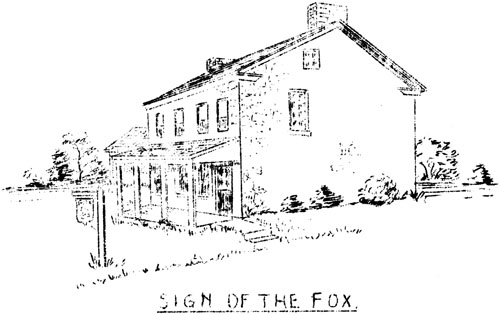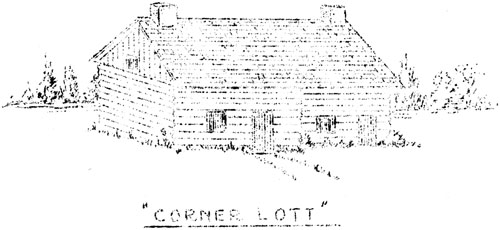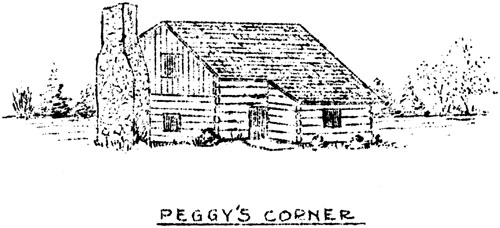|
Home : Quarterly Archives : Volume 7 |
Tredyffrin Easttown Historical Society |
|
Source: July 1952 Volume 7 Number 3, Pages 60–67 Berwyn in the pre-Revolutionary and centennial periods
Sign of the Fox Sometime during the late Colonial or pre-Revolutionary period a straggling hamlet of less than a score of humble homes extended for half a mile or more along the Provincial, later known as the Conestoga, Lancaster, or Old Road, from a short distance in Easttown east of the Fox Tavern to a little beyond Peggy's Corner in Tredyffrin; it flourished up to the Turnpike era. Although situated on the first and chief inland highway of the Province, it was somewhat isolated locally. The nearest crossroad, the Welsh line or Baptist Road was a mile to the east and the Bear Road a mile and a half to the west. There then existed, however, a private road or right of way through the Atkinson, later John Reese land, leading down to the Griffith John plantation in the valley and on out to the Swedesford Road near Wilson's Corner. Another bypath began at Peggy's Corner, which gave access to the Neilley's and continued down the wooded ravine to the Black Swan distillery and beyond through the John and Reese plantations, with several gates, to the Swedesford Road opposite the present entrance to Chesterbrook Farm. A third ancient lane, a quarter of a mile west of Peggy's corner, entered deeply in the hills and turned to a dead end, giving access to the residents of some five or six log houses on the southern exposure of the hills, but this right of way extended no further, except by foot path to Howell's Tavern, now Howellville. Scarcely more than a hundred yards north of the Old Road at any point, and sometimes bordering it, was an almost unbroken forest of deciduous timber with here and there a stand of pitch pine, and frequently a dense border of red cedar. The hills and ravines of the Slate ridge or South Valley hills had also a dense undergrowth of laurel and wild grape vine and the small bogs or swamps an almost impenetrable mass of spicewood and green-brier. The dwellings of this early settlement called "Cockletown" were mostly of the log cabin type, built of oak or chestnut logs, with stone chimneys; occasionally one more pretentious had stout stone gable ends. However, they were mostly small and homely, erected so close to the right of way that the inhabitants could step from the doorsill directly into the road. On one side was the woodpile and the well with its windlass and oaken bucket, on the other the lye barrel, the lilac bush, the clump of hollyhocks, and more than likely the pig pen. Few of these tenants or small land owners kept a horse; "shank's mare" was the custom when going away, but few were without a cow, at least two hogs, and a flock of poultry. The cleared plots were not extensive, though large enough to grow enough corn, potatoes, cabbage, turnips and pumpkins to carry the family and stock over the winter. However remote from town, Cockletown was by no means lonely. Until about 1730 the Old Road had been almost exclusively as a pack-horse trail, as it had been more anciently an Indian path. Later it became a thoroughfare fifty feet wide for traders, immigrants, drovers, freighters in Conestoga wagons, etc., deep in mire or dust according to the season or state of the weather, and the small homesteader could no longer plant his corn in the middle of the road and require the occasional traveler to detour as best he could.
Corner Lott Proceeding westward on the Old Lancaster Road in Easttown, there were two small log houses on the north side, one in front of where Westley Jones, shoemaker, built his new frame house in 1882, and the other close to the entrance to the late Dr. Okie's place. On the south side there was at least one, possibly two, log dwellings. Then came the Fox Tavern, the only building entirely of stone. Its erection is of unknown date. Sachse informs us that it was kept by Fox from 1792 to 1797 and by David Llewellyn until 1804, when it ceased to be a place of public entertainment and became a country store. On the north side of the Old Road there was a stone and log dwelling about where Dr. Wharton's house now stands, but closer to the road. This may have been built by Abel Thomas, carpenter, who owned about seventy acres in the vicinity in 1785, mostly in the woods. This house was later occupied by widow Jane Dane after she had retired from the Spring House Tavern. A short distance west on the opposite side there was a blacksmith shop. The site was probably immediately in front of the cottage built recently by Levering Latch, where scrap iron and a cannon ball were recently unearthed. The John Reese house, formerly the residence of Reverend Dr. Sagebeer, doubtless dates from the Reese ownership. This was of logs, now weather-boarded. The low log barn dated from 1830 and was removed about 1880. The first house on the John Reese farm was a small one of logs close to the public road, on the extreme southwest corner of that portion of land north of the Old Road and close to the entrance of the wood road to Griffith John's plantation in the valley. It has been described as having one and a half stories, with a door and two small windows in front. The original Drove Tavern was on the site of the Fritz house, and was reached from the Old Lancaster Road by a lane. There is little information of the date of its construction or of the original owner. On the north side of the Old Road and west of the John Reese farm was the Burns' farm, as it became known. After several sales and transfers of title it came into the possession of Sebastian Rink, a shoemaker, vestryman at St. Davids, 1765 to 1769. He replaced the original log cabin with a mansion (in those days) of thick stone gable trails and dressed log, front and rear, and caused to be traced deeply in the mortar of the countersunk square high up in the west gable "B. R. 1767." This house was lately the residence of Mr. George P. Orr, who greatly enlarged and remodeled it. The next habitation was immediately in front of the Robert Doyle's late residence, long known as "Peggy's Corner", an ancient log cottage which Dr. Quimby immortalized as "Peggy Hambleton's Cake and Beer Shop."
Peggy's Corner The last house on the main highway in Cockletown was near the present house formerly occupied by the late S. Paul Teamer. It was a long low structure of logs and of two periods, the easternmost section very old and uninhabitable fifty years ago, the western end built about eighty years ago, where a tenant at one time kept a night school. With the advent of the Turnpike, Cockletown became just another backwoods settlement and eventually the northern part of Reeseville, later Berwyn. During the Centennial period the little village of Reeseville was considered one of the most quaint and charming places along the Main Line. Altogether it contained about forty dwellings, a Presbyterian Church, Cleaver's general store, Lobb Brothers feed, coal and lumber yard, Kelly's tin shop, Egbert Bloom's harness shop, Morris Lewis' carpenter shop, Thomas Aiken's carpet weaving shop, McLeod's blacksmith and wheelwright shop, occupied about this time by William Epright. There was a population of about two hundred, counting from Neilley's to Leamey's and from John Smith's (Wynburn) farm to the Brown Row on the pike. The buildings and grounds were exceptionally well kept with well-formed trees, old-fashioned flowers, neat lawns, gardens and pastures, surrounded by white-washed picket fences. Some of the inhabitants were not at all pleased with the homely name of Reeseville and determined to make a change without offense to their Welsh neighbors. At length it was proposed to name the village after the Berwyn Hills overlooking tho beautiful valley watered by the river Dee, Merionethshire, Wales. Our village overlooked from a commanding height the beautiful, pastoral valley of Chester. Berwyn received the official sanction of the United States Post Office Department in 1877. There were no roads or avenues except Church Avenue (Main) from the Station to the Presbyterian Church, and Berwyn Avenue from Waterloo Road to the same edifice and a little beyond, to provide egress for the newly built dwellings of Harriett Davis and William Clark, who had built an imposing mansion. The incipient village site from east to west included the McLeod Farm which originally extended between Church and Waterloo Avenues, the Aiken farm from Waterloo Road to near the present Bridge Avenue and the Dr. Henry Y. Carter farm to the Potter line. In 1877 the Pennsylvania Railroad rebuilt the roadbed to reduce grades and eliminate the numerous short curves previously deemed necessary. The Carter Farm house and barn and the old Newtown and Howellville Road bridge were demolished; the Aiken houses and the Fritz warehouse were moved back by an expert mover, much to tho astonishment of the inhabitants, without disturbing the tenants. The Leopard Road was routed to connect with the pike on the south side and an underpass built for the pike at the eastern end of the Village; thus two dangerous grade crossings were eliminated. Enos Reese Lewis bought the Carter Farm and laid it out in building lots in 1878. The new avenues, Bridge and Central, were designated by posts a long way apart and strung with a strand of telegraph wire. Little or no attempt was made to make grades or gutters and during the greater part of the year there was literally no place to plant a booted foot, yet the lots of this tract and that of the Aiken Farm on Waterloo, Berwyn and Knox Avenues sold rapidly. The first buildings on the Reese development were Reese's own mansion, later used as a public school building, Huffington's, Mrs. Barnett's and William Hartman's. In building there was a regrettable lack of restrictions as to grade, alignment, quality, architecture, etc. Lumber of the best grade and skilled labor were cheap; carpenters received $1.75 for a day of ten hours. The result collectively and individually left every tiling to be desired artistically, but many secured comfortable homes, stove-heated and cistern-watered to be sure. Later, when bathrooms cane within the reach of many, wells were drilled by Frank Leamy and everywhere the windmill erected its whirling, squeaking head. The laying of water pipes by the Springfield Water company has eliminated the windmill. The building program received financial aid from the Berwyn Building and Loan Association which was incorporated in 1878. The incorporation of a "Hall end Library Association" in 1878 with shares at $20.00 led to the organization of a Lyceum in the new Hall (located on Main Street back of the Presbyterian Church) in which much local talent was discovered. I. A. Cleaver and J. W. Sharp were active in this movement, and Henry T. Coates of the publishing firm of Porter and Coates presented the Library with many standard works and the Reading Room with chess, checkers, and backgammon. The Library was open Saturday afternoon and evening with James T. Doran in charge. In 1878 Mrs. James T. Doran, wife of the Secretary of the Corn Exchange, with her sister, Miss Freeman, opened the Spring Cottage Seminary. This was in their residence, now the Nuzum house, in the rear of the bank. The large shady grounds then extended to the pike. The school was filled to its capacity for some years by youths and maidens of the neighborhood who were eager for a higher education than the Public Schools could afford. The subjects taught were French, Latin, Mathematics, English and vocal and instrumental Music. Later James Doran, who was a perfect genius mathematically, took over the school, and a new building was erected for the purpose on Church Avenue. John F. Kauffman organized and conducted a singing school each winter. A "String Band" or orchestra was also formed with a German teacher. It met for practice at various homes. The original hall at Berwyn was the cradle of four of its village churches. Baptist Chapel, 1878; St. Monica's Roman Catholic Church, 1878 (the corner stone was laid in 1889); the Methodist Episcopal Church, 1888; and the First Baptist (originally called the "People's Baptist") in 1902. The Berwyn Baptist Sunday School had i t s birth on the afternoon of November 24,1878, in the new hall with Deacon Isaac Cleaver as Superintendent and J. F. Kauffman as song leader. A "Village Improvement Society" was formed in June 1888 with Isaac Cleaver as President and Frank Glosser as Secretary. It devoted its efforts chiefly to the construction of boardwalks from the Pike to the Presbyterian Church and to Cleaver's Store, and to the erection of a dozen coal-oil lamps. The village of Berwyn was strategically situated as a rural business center. From the north, roads came in from the vicinity of Howellville, Valley Forge and New Centreville, on the south lay Waterloo Mills (Cabbagetown) and "Pinchtown". The Darby Creek Paper Mills, and the rich country about Wyola, Newtown, Leopard and White Horse was near. There was Glassley to the east and Mt. Airy (Daylesford) west. The farmers came here to buy and sell and to attend religious and secular meetings. It was the high tide in the local production of food stuffs. The milk train stopped regularly to load the numerous rattling cans. Twice a week, at the Farmer's Market in Philadelphia beef, veal, mutton, lamb, poultry, eggs, butter, and cheese were sold. There was a limited supply of fruits and vegetables in season, and pork, scrapple, lard and sausage during the colder weather. Always on Tuesday and more often on Friday afternoons the heavily laden farm wagons, plentifully bespattered with mud, rattled down the streets. The sturdy teams of farm horses were driven by farm boys, there would be a final burst of speed as they entered the village. On every wagon, seated beside the driver, was the farmer himself, "dressed in his Sunday best," for it was his pleasure to "stand" in the market stall. He would be there bright and early the following morning and dispose of his produce to his regular customers. In the winter when the roads were covered with snow, the farmers arrived in great bobsleds and it was great fun for the school children to steal a ride. The Berwyn market car was often insufficient to hold all the dressed meat, butter tubs and egg boxes. It was a matter of pride to have butter, sausage scrapple, etc. of surpassing excellence and consequently, in great demand. Most of the farmers were men of character and substance who established an intimate clientele. Family teamwork was essential, but the returns were immediate and satisfactory. The decline followed refrigeration of produce from cheap western lands, increased city rentals, and the abandonment by City housekeepers of their personal marketing. So the wheel of time keeps turning, sweeping men and conditions along. The things that occupied us and were important, within a few years become obsolete. Some one has said that "Time takes everything except our memories," but as we look back we find that even our memories change and are tempered by Time. Berwyn at the present time is a quiet little village, pleasant to live in but not overcome by ambition. Data for this article were obtained from unpublished notes of Mr. Franklin L. Burns written some years ago, and from his article "Chronicles of Old Cockletown" T-E Quarterly Volume I, number 2, January 1938. |


